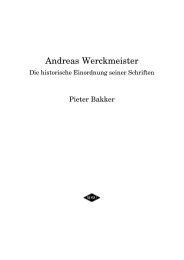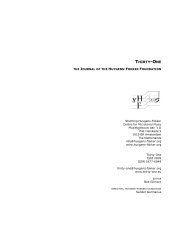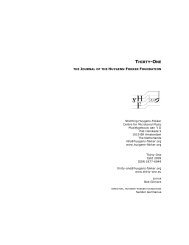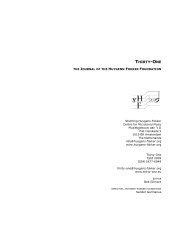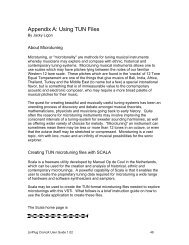Recent Organ Design Innovations and the 21st-century - Stichting ...
Recent Organ Design Innovations and the 21st-century - Stichting ...
Recent Organ Design Innovations and the 21st-century - Stichting ...
Create successful ePaper yourself
Turn your PDF publications into a flip-book with our unique Google optimized e-Paper software.
Like <strong>the</strong> organ in Sinzig, <strong>the</strong> new organs in St. Peter’s Church, Cologne feature many reed,<br />
mutation, <strong>and</strong> percussion stops in addition to unique console devices; however <strong>the</strong>se later instruments<br />
develop <strong>the</strong> Sinzig ideas into a more unified tonal concept. An active Jesuit church whose structure<br />
dates back to <strong>the</strong> 12th <strong>century</strong>, St. Peter’s in Cologne became home to <strong>the</strong> new “Kunst-Station” in 1987.<br />
Established as a center for contemporary art, <strong>the</strong> Station offers residences for artists <strong>and</strong> composers <strong>and</strong><br />
features regular concerts, art installations, <strong>and</strong> readings. The large modernist case in <strong>the</strong> back balcony,<br />
incorporating <strong>the</strong> pipework of <strong>the</strong> previous neo-baroque organ, plus <strong>the</strong> newer eight-meter-tall choir<br />
organ situated on <strong>the</strong> floor in <strong>the</strong> front left side easily dominate <strong>the</strong> interior visual space. While <strong>the</strong><br />
choir organ boasts its own three-manual console, <strong>the</strong> four-manual detached console in <strong>the</strong> balcony can<br />
play both, allowing <strong>the</strong> two instruments to work toge<strong>the</strong>r as one. Both were built under Bares’s<br />
guidance by <strong>the</strong> Cologne firm Willi Peter Orgelbau. Full specifications of <strong>the</strong> organs as well as<br />
explanations from many of <strong>the</strong> musicians <strong>and</strong> builders involved with <strong>the</strong>ir creation <strong>and</strong> current<br />
performance is available in two volumes titled Werkzeuge der Stille. 16<br />
Colorful mutations <strong>and</strong> mixtures abound, including numerous sevenths, ninths, <strong>and</strong> elevenths.<br />
The four Cymbel mixtures on <strong>the</strong> floating Koppelwerk feature highly unusual partials, including 2/13,<br />
2/15, 2/17, 2/19, 4/21, <strong>and</strong> 8/27. In addition to a full battery of reeds in each division, manual II<br />
features a free-reed Physharmonika at 8’, 16’, 32’, <strong>and</strong> 64’ pitches, while <strong>the</strong> Koppelwerk contains a<br />
Saxophon at 4’, 8’, 16’, <strong>and</strong> 32’ pitches. There is a programmable mixture, or chromatic coupler, using<br />
<strong>the</strong> Sinzig push-button layout, available at any <strong>and</strong> all intervals one octave above as well as one octave<br />
below <strong>the</strong> given pitch. We find many of <strong>the</strong> same percussion, including a Psalterium. Additionally, <strong>the</strong><br />
console features a sustain capability much <strong>the</strong> same as that in Sinzig.<br />
16 Gassmann, Boll, <strong>and</strong> Danch, eds., Werkzeuge der Stille; Michael Gassmann, ed., Werkzeuge der Stille II:<br />
Die neuen Orgeln in Sankt Peter zu Köln (Cologne: Fries Printmedien, 2007).<br />
15



